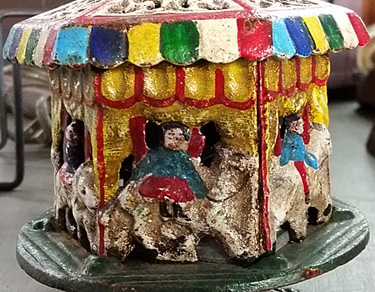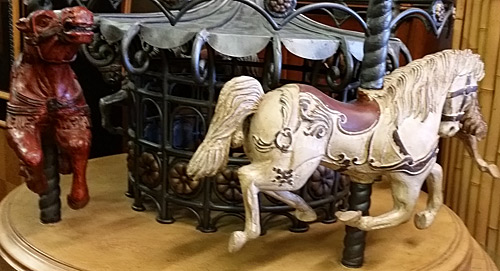Who doesn’t love a carousel? They evoke memories of carnivals and state fairs without the hair-raising and screaming fits of roller-coasters. They are the genteel rides, slow and steady, their immobile horses guiding you in a rhythmic nod of carefree fun.
I recently came across three sets of carousel horses at two different auction houses in one day. I hadn’t seen that many large ones since an antique dog and pig were sold at auction several years ago. I was at an estate sale more recently when some tabletop carousel figurines were snatched up by bidders.
The first carousels date back to the 12th century with Arab and Turkish horsemen in a game viewed by Spanish and Italian crusaders who dubbed it “little war” in their own languages. The game made its way to France where it evolved into one called carrousel – first with live men and horses, and then with carved pieces, according to the International Museum of Carousel Art in Oregon. That became the carousel as we know it today.

By the 1700s, carousels could be found in amusement parks throughout Europe. They were first made in the United States around the mid-1800s, and were popular from the 1880s to the 1930s. The figures were made by master carvers in the forms of various kinds of animals, including horses, ponies, dogs and cats, and tigers.
Although thousands were built, only a few hundred still exist. The Please Touch Museum in Philadelphia restored a 1908 carousel, the Woodside Park Dentzel Carousel, made by one of the country’s major carousel makers, Dentzel. The carousel at this children’s museum consists of 52 wooden animals, including horses (40 of them), cats, pigs and rabbits. It includes a replica of the “flirting rabbit,” a trademark of the Dentzel company; the figure resembles a rabbit waving its paw.
The museum is not the only one intent on preserving the carousel. Several museums across the country have been formed to preserve them and their history. The website of the National Carousel Association has lovely photos of restored carousels.
Horses seemed to be the most common of carousels animals, as they are in today’s puzzle. Can you guess how they were used? Click on the last photo to find out.


